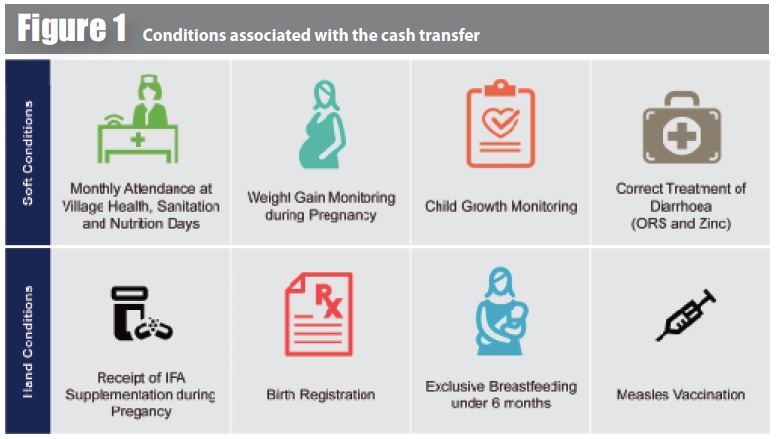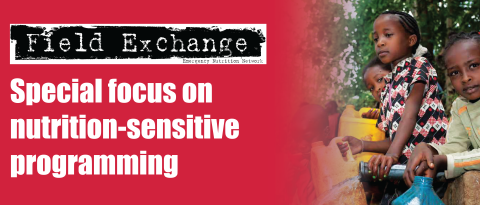Impact of an integrated agriculture and nutrition and health behaviour change communication programme for women in Burkina Faso
Summary of research1
Location: Burkina Faso
What we know: The agricultural sector has great potential to contribute to improving nutrition.; However, current evidence of agriculture’s impact on child nutrition is limited.
What this article adds: A randomised controlled trial (RCT) assessed the impact (anaemia, wasting and diarrhoea amongst children aged 33 to 12.9 months) of Helen Keller International’s (HKI)’s two- year integrated agriculture (homestead food production) ) and nutrition and health behaviour change communication programme (BCC) in Burkina Faso. When implemented by members of a health committee, there were significant improvements in wasting (marginal), diarrhoea, and anaemia, especially among the youngest children. Plausibility is supported by significant improvements that were also found in women’s agriculture production, infant and young child feeding (IYCF) practices and household dietary diversity.
This paper summarises the results of a randomised controlled trial (RCT) that assesses the impact of Helen Keller International’s (HKI’s) two- year integrated agriculture (homestead food production) (homestead food production – HFP) and nutrition and health behaviour change communication (BCC) programme in Burkina Faso. The study assesses the impact of the programme on anaemia, wasting and diarrhoea in infants and young children.
Anaemia and acute undernutrition are widespread among young children in Burkina Faso. Anaemia is nearly universal at 92% among children younger than five years of age years of age (the highest prevalence in the world). Burkina Faso also has the highest prevalence of moderate-to-severe anaemia (45% among children six6 to 23 months of age) and the highest prevalence of wasting (at 14%) in sub-Saharan Africa. Undernutrition and anaemia share several risk factors, including illness and energy and micronutrient deficiencies. Lack of access to high-quality foods, especially tied to seasonal variations and water shortages; sub-optimal infant and young child feeding (IYCF); and poor hygiene and sanitation practices likely contribute to energy and micronutrient deficiencies and increased exposure to pathogens that cause diarrhoea and other infections.
The 2013 Lancet series on maternal and child nutrition emphasises the need to address the underlying determinants of malnutrition through multi-sectorial, nutrition-sensitive programmes, alongside nutrition- specific programmes, in order to improve nutrition in the first 1,000 days of life (Black, Victora, Walker et al, 2013). Agriculture is one sector that has great potential to contribute to improving nutrition. However, current evidence of agriculture’s impact on child nutrition is limited, due to weaknesses in programme targeting, design and implementation. The aim of this study is to strengthen this body of evidence.
Method
 The authors use a cluster-randomised controlled trial RCT to assess the impact of the HKI programme, which integrates agricultural production activities with a strong nutrition and health BCC strategy with the explicit goal of improving children’s nutritional outcomes. Agricultural production activities included input distribution (e.g. seeds, saplings, chicks and small gardening tools) and agriculture training provided by four female village farm leaders at demonstration farms. The BCC strategy included communication on women’s nutrition, anaemia prevention and control, iodine intake, prevention of vitamin A deficiency, breastfeeding practices, complementary feeding practices and nutritional care for sick and severely malnourished children. Participating women received home visits twice per month from either an older woman leader (OWL) from within the community or a health committee (HC) member, with links to health services. The two types of actors were selected to understand how the effectiveness of the BCC strategy may vary according to the type of actor delivering messages.
The authors use a cluster-randomised controlled trial RCT to assess the impact of the HKI programme, which integrates agricultural production activities with a strong nutrition and health BCC strategy with the explicit goal of improving children’s nutritional outcomes. Agricultural production activities included input distribution (e.g. seeds, saplings, chicks and small gardening tools) and agriculture training provided by four female village farm leaders at demonstration farms. The BCC strategy included communication on women’s nutrition, anaemia prevention and control, iodine intake, prevention of vitamin A deficiency, breastfeeding practices, complementary feeding practices and nutritional care for sick and severely malnourished children. Participating women received home visits twice per month from either an older woman leader (OWL) from within the community or a health committee (HC) member, with links to health services. The two types of actors were selected to understand how the effectiveness of the BCC strategy may vary according to the type of actor delivering messages.
The authors used a longitudinal design and followed the same households, mothers and children over the two- year programme implementation period. The baseline study was conducted between February and May 2010 (when children were 33 to -112.9 months of age) and the end line survey was conducted between February and June 2012 (when children were 24-39.9 months of age).
Outcomes of children were measured including anthropometry (stunting, wasting and underweight), mean haemoglobin (Hb) (anaemia defined as Hb < 11 g/dL, severe anaemia as Hb < 7.0 g/dL) and diarrhoea prevalence. In order to establish plausibility of findings, data were also collected on intermediary outcomes along hypothesised programme impact pathways, from agricultural production to consumption of nutrient-rich foods and from maternal acquisition of knowledge to adoption of optimal IYCF and health practices.
Fifty-five Fifty five villages in four departments in Gourma province were randomly assigned to three groups as follows: 1) control group that received no interventions from HKI (n=25 villages), 2) treatment group that received the agricultural production intervention with the BCC strategy implemented by OWLs (n=15 villages), and 3) treatment group that received the same agricultural production with the BCC intervention implemented by HC members (n=15 villages). Data were collected at baseline and end line on household demographic and socioeconomic characteristics, gender- disaggregated asset ownership and value, agricultural production, household dietary diversity, health and nutrition knowledge (maternal recall), and IYCF practices. In order to measure anaemia, capillary blood from a finger prick sample was used immediately to measure Hb. For anthropometric measures, trained staff measured weight with the use of an electronic scale whereby weight (to the nearest 100 g) was first taken for mother and child and secondly for the mother alone, the difference being the child’s weight. Recumbent length of children < 2 y of age and standing height of children > 2 y of age was measured to the nearest 0.1 cm with the use of a wooden length board. Length/Length of children two years of age years of age was measured to the nearest 0.1 cm with the use of a wooden length board. hHeight- for- age Z-sz score (HAZ), weight- for- age Z-sz score (WAZ) and weight- for-length/ height Z-sz score (WHZ) values were calculated using the 2006 WHO growth standard.
Results
In the 55 villages, 1,767 households participated in the baseline survey, and of these 1,481 participated in the endl line survey. The HFP programme had a marginally significant impact on improving mean Hb among children aged 3-123–12.9 .9 months of age at baseline living in HC villages compared with control villages (P = 0.06). This difference was larger and statistically significant among children aged 3-3–5.9 months of age at baseline (P = 0.02). In addition, there was a greater decrease in the prevalence of anaemia (P = 0.02) among these younger children in HC villages than in control villages. A statistically significant difference was also found in the reduction of diarrhoea among children 33-–12.9 months of age living in HC villages compared with control villages. A similar trend was seen among children living in OWL villages compared with control villages, although the difference between the two groups was smaller and was only marginally significant. Programme impacts on anthropometric measures were restricted to a marginally statistically significant (P = 0.08) greater decrease in the prevalence of wasting among children 33-–12.9 months of age at baseline in the HC villages than in the control villages.
The plausibility of findings is supported by statistically significant positive impacts on intermediary outcomes along the programme impact pathways in HC villages compared with control villages. This included increases in women’s agriculture production and health- and nutrition-related knowledge and practices, including IYCF practices and in household dietary diversity. The authors suggest that larger impacts on these intermediary outcomes and on children’s nutrition and health outcomes would have been achieved with earlier and longer exposure to the programme.
Conclusions
 The authors conclude that HKIs two- year integrated HFP and BCC programme when implemented by members of a health committee significantly improved several child outcomes, including wasting (marginal), diarrhoea, and anaemia, especially among the youngest children. This is the first cluster-randomised controlled trial RCT of an HFP programme that documents statistically significant positive effects on these child nutrition outcomes. The authors argue that modest impacts achieved over a two- year period are meaningful and hold promise for future investments in integrated agriculture and nutrition programmes.
The authors conclude that HKIs two- year integrated HFP and BCC programme when implemented by members of a health committee significantly improved several child outcomes, including wasting (marginal), diarrhoea, and anaemia, especially among the youngest children. This is the first cluster-randomised controlled trial RCT of an HFP programme that documents statistically significant positive effects on these child nutrition outcomes. The authors argue that modest impacts achieved over a two- year period are meaningful and hold promise for future investments in integrated agriculture and nutrition programmes.
Footnotes
1 Olney, D.K., Pedehombga, A., Ruel, M.T. and Dillon, A. (2015). A 2-year integrated agriculture and nutrition and health behavior change communication programme targeted to women in Burkina Faso reduces anaemia, wasting, and diarrhoea in children 3-12.9 months of age at baseline: a cluster-randomized controlled trial. Nutr. 2015 154:6 1317-1324. doi:10.3945/jn.114.203539
References
Black, R.E., Victora, C.G., Walker, S.P., Bhutta, Z.A., Christian, P., de Onis, M., Ezzati, E., Grantham-McGregor, S., Katz, J., Martorell, R., et al. (2013). Maternal and child undernutrition and overweight in low-income and middle-income countries. Lancet 2013; 382:427–51.


